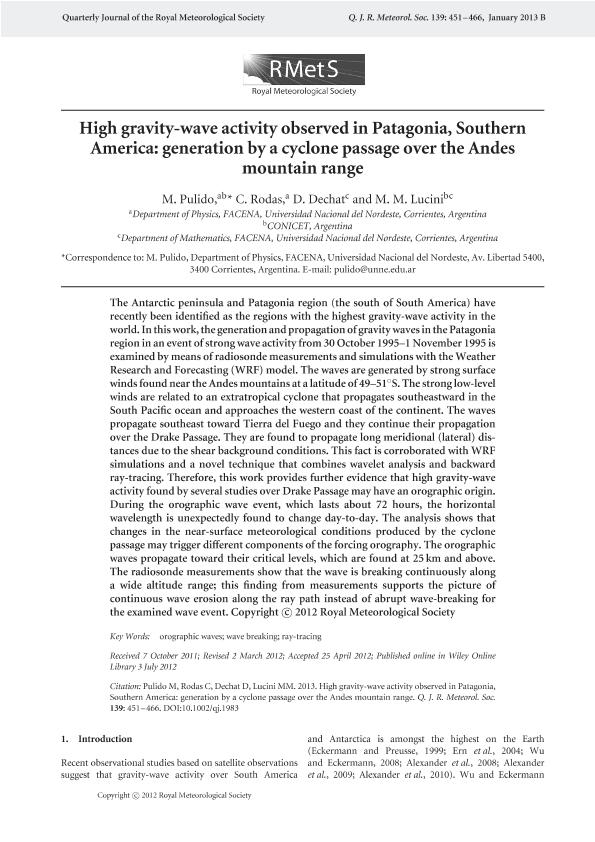Mostrar el registro sencillo del ítem
dc.contributor.author
Pulido, Manuel Arturo

dc.contributor.author
Rodas, Claudio José Francisco

dc.contributor.author
Dechat, Diego

dc.contributor.author
Lucini, María Magdalena

dc.date.available
2017-08-07T19:01:41Z
dc.date.issued
2012-07
dc.identifier.citation
Pulido, Manuel Arturo; Rodas, Claudio José Francisco; Dechat, Diego; Lucini, María Magdalena; High gravity-wave activity observed in Patagonia, Southern America: generation by a cyclone passage over the Andes mountain range; Wiley; Quarterly Journal of the Royal Meteorological Society; 139; 671; 7-2012; 451-466
dc.identifier.issn
0035-9009
dc.identifier.uri
http://hdl.handle.net/11336/21970
dc.description.abstract
The Antarctic peninsula and Patagonia region (the south of South America) have recently been identified as the regions with the highest gravity-wave activity in the world. In this work, the generation and propagation of gravity waves in the Patagonia region in an event of strong wave activity from 30 October 1995–1 November 1995 is examined by means of radiosonde measurements and simulations with the Weather Research and Forecasting (WRF) model. The waves are generated by strong surface winds found near the Andes mountains at a latitude of 49–51°S. The strong low-level winds are related to an extratropical cyclone that propagates southeastward in the South Pacific ocean and approaches the western coast of the continent. The waves propagate southeast toward Tierra del Fuego and they continue their propagation over the Drake Passage. They are found to propagate long meridional (lateral) distances due to the shear background conditions. This fact is corroborated with WRF simulations and a novel technique that combines wavelet analysis and backward ray-tracing. Therefore, this work provides further evidence that high gravity-wave activity found by several studies over Drake Passage may have an orographic origin. During the orographic wave event, which lasts about 72 hours, the horizontal wavelength is unexpectedly found to change day-to-day. The analysis shows that changes in the near-surface meteorological conditions produced by the cyclone passage may trigger different components of the forcing orography. The orographic waves propagate toward their critical levels, which are found at 25 km and above. The radiosonde measurements show that the wave is breaking continuously along a wide altitude range; this finding from measurements supports the picture of continuous wave erosion along the ray path instead of abrupt wave-breaking for the examined wave event. Copyright © 2012 Royal Meteorological Society
dc.format
application/pdf
dc.language.iso
eng
dc.publisher
Wiley

dc.rights
info:eu-repo/semantics/openAccess
dc.rights.uri
https://creativecommons.org/licenses/by-nc-sa/2.5/ar/
dc.subject
Orographic Waves
dc.subject
Wave Breaking
dc.subject
Ray-Tracing
dc.subject.classification
Oceanografía, Hidrología, Recursos Hídricos

dc.subject.classification
Ciencias de la Tierra y relacionadas con el Medio Ambiente

dc.subject.classification
CIENCIAS NATURALES Y EXACTAS

dc.title
High gravity-wave activity observed in Patagonia, Southern America: generation by a cyclone passage over the Andes mountain range
dc.type
info:eu-repo/semantics/article
dc.type
info:ar-repo/semantics/artículo
dc.type
info:eu-repo/semantics/publishedVersion
dc.date.updated
2017-07-27T12:53:50Z
dc.journal.volume
139
dc.journal.number
671
dc.journal.pagination
451-466
dc.journal.pais
Estados Unidos

dc.journal.ciudad
Hoboken
dc.description.fil
Fil: Pulido, Manuel Arturo. Consejo Nacional de Investigaciones Científicas y Técnicas. Centro Científico Tecnológico Conicet - Nordeste. Instituto de Modelado e Innovación Tecnológica. Universidad Nacional del Nordeste. Facultad de Ciencias Exactas Naturales y Agrimensura. Instituto de Modelado e Innovación Tecnológica; Argentina
dc.description.fil
Fil: Rodas, Claudio José Francisco. Universidad Nacional del Nordeste. Facultad de Ciencias Exactas y Naturales y Agrimensura. Departamento de Física; Argentina
dc.description.fil
Fil: Dechat, Diego. Universidad Nacional del Nordeste. Facultad de Ciencias Exactas y Naturales y Agrimensura. Departamento de Matemática; Argentina
dc.description.fil
Fil: Lucini, María Magdalena. Consejo Nacional de Investigaciones Científicas y Técnicas. Centro Científico Tecnológico Conicet - Nordeste; Argentina. Universidad Nacional del Nordeste. Facultad de Ciencias Exactas y Naturales y Agrimensura. Departamento de Matemática; Argentina
dc.journal.title
Quarterly Journal of the Royal Meteorological Society

dc.relation.alternativeid
info:eu-repo/semantics/altIdentifier/url/http://onlinelibrary.wiley.com/doi/10.1002/qj.1983/abstract
dc.relation.alternativeid
info:eu-repo/semantics/altIdentifier/doi/http://dx.doi.org/10.1002/qj.1983
Archivos asociados
